| Sugar Syrup Propellant |
Improved version
Click Here for description |
An alternative method of making KN/Sucrose propellant
Please Note: The propellant DOES NOT EVER go in
the microwave oven!
Only the sugar syrup is made there.
If the propellant is reheated, it must be done in a conventional oven
such as a toaster-oven.
Overview:
Sugar and corn syrup are mixed in a heavy glass vessel, and heated
to boiling in a microwave oven.
The vessel is removed from the oven, taken to a safe spot, and pre-heated
KNO3 is stirred-in.
Advantages:
- It is a quick and simple way to make KN/SU propellant.
- Seems reasonably safe if appropriate precautions are taken.
- Sugar syrup can be made on a camp stove, so this method could be
used in the field.
- The propellant works OK in test motors, most likely it will work
in flight tests as well.
Disadvantages:
- The experimenter is exposed to hot propellant for a brief period
while the KNO3 is stirred-in.
- Requires grinding or milling of the KNO3, not necessary with recrystallization
- There is more waste with this method (but scraps can be recycled
as recrystallized propellant or fertilizer)
- The resulting propellant is inferior in quality to the recrystallized
version.
It is more brittle, does
not burn as cleanly, and seems to offer lower delivered ISP
When re-heated, it does
not easily attain the fine texture and pliability of recrystallized propellant.
- It is easy to overcook the syrup, turning it brown. The resulting
propellant will ignite with difficulty and burn very slowly. This
might be OK for larger motors with adequate pyrogen ignition.
Here is the initial recipe:
(note that this has been refined, see below)
-
100g KNO3, finely powdered
-
50g cane sugar
-
30g Karo syrup (corn syrup)
The KNO3 is placed in a pan and heated to 200 degrees in a conventional
oven.
This is to keep it from cooling down the sugar syrup too much when
it is added.
Warm KNO3 mixes in easier and allows a longer working time.
Sugar and corn syrup are placed in a 1-quart Pyrex measuring pitcher,
mixed together, and heated in a microwave oven on "high" until the liquid
is perfectly clear.
Heavy shirt, face mask, and gloves are used to make the body more attractive
and flame-resistant, just in case.
Sugar syrup is stirred to eliminate any "hot spots." Then the KNO3 added,
and everything is stirred vigorously with a wooden spoon. Whilst
stirring, mouth of glass container is pointed away from face and other
things of importance, just in case.
Upon cooling, this propellant tends to be somewhat crumbly and more
brittle than recrystallized propellant. Heating to 200 degrees F
does not soften it like recrystallized. But heating to 250 to 270
degrees brings it to a near-liquid state, at which point it can be stirred
and then kneaded as it cools a bit. The result is a propellant with
a texture and molding characteristics similar to recrystallized KN/SU.
I believe it is somewhat less brittle after the heating/kneading procedure
- this will be tested soon.
Static Tests
Here are a couple of uninhibited grains burned in a test-motor.
The motor is 1-1/4 inch PVC, using the steel nozzle Foy gave me 2 years
ago. The nozzle has been used a hundred or so times, and is still
in good shape. Throat diameter is 5/16 inch.
 |
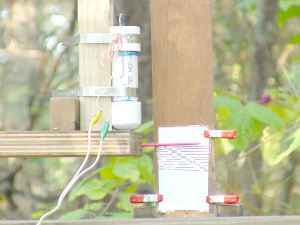 |
| General idea of the test motor, PVC case with steel nozzle |
Crude but effective test stand. Well... crude, anyway. |
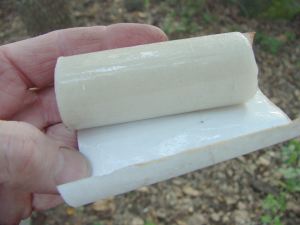 |
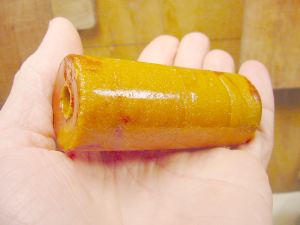 |
Light propellant, sugar syrup cooked until clear
Click Here to see how this grain burns
Hint: Pretty darned well!
(800k download, 5 seconds of video) |
Dark propellant, sugar syrup cooked until brown.
Click Here to see how this grain burns
Hint: Not well at all
(3.5 meg download, 12 seconds of video) |
How's this for a finale: see what happens when you
rush things and don't give the PVC cement enough time to dry!
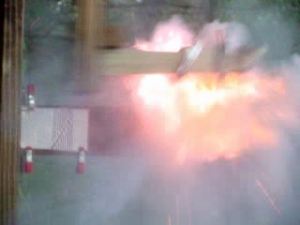
Click Here for a movie of this burst.
(1.6 meg file for 6 seconds of exciting video)
Summary: Cap at the head-end came off - the case was otherwise
intact. Prime suspect: bad glue job.
Comparison of sugar syrup propellant and recrystallized
propellant
Two motors were assembled to be as near identical as my little hands
can make them, and fired on the test stand to compare their performance.
| Sugar Syrup propellant - 10/6/03A |
Recrystallized propellant - 10/6/03B |
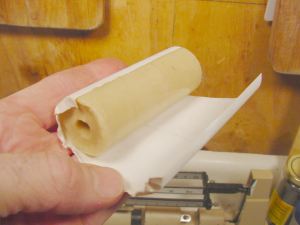 |
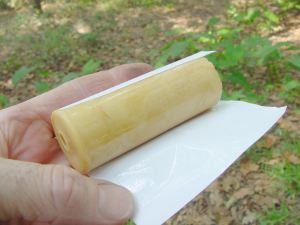 |
Click Here to see this baby burn!
(950k file, 4 seconds of video)
Or Here for an Excel spreadsheet
analyzing this test |
Click Here for a video of this grain in
static test
(975k file, 4 seconds of video)
Or Here for an Excel spreadsheet
analyzing this test |
Results: As expected, the recrystallized propellant performed
better, a 120 gram uninhibited grain providing 133 N-seconds of thrust
as compared to the sugar syrup propellant offering 112 N-secs. ISPs
are 112 and 95, respectively. Thus the recrystallized propellant
appears roughly 18% more effective.
Then again, a single pair of tests is hardly definitive. And there
were other differences that could account for the discrepancy, not the
least of which were limited resolution of the videos leading to some guessing
as to where the pointer pointed on some frames. And "bouncing" of
the test stand, which was overwhelmed by the thrust of these motors.
Also, the 1 atm. burn rates of the propellants was different, A =7
seconds per inch, B=12 seconds per inch, but the recrystallized grain (B)
burned a bit more quickly than the sugar syrup grain (A) despite its slower
open-air burn rate.
Oh, it occurs to me that this propellant is rather fuel-rich, as evidenced
by the recipe, which would be nearly balanced except for the addition of
corn syrup, which contains many sugars. The carbon-rich residue is
verification that the sugar syrup propellant contains an excess of fuel.
10/11/03B: Revised recipe, better oxidizer/fuel
ratio:
-
100g KNO3
-
40g cane sugar
-
30g Karo syrup
This was made out on the picnic table using a Coleman stove, no microwave
oven needed. Sugar and corn syrup were heated in one small pan, while
KNO3 warmed in another pan on the second burner.
Since there was less syrup, the propellant hardened more quickly and
a lot of it stuck to the mixing container. So
there was more waste* in this batch, and the grain only came to 108.2
grams. I fired it anyway in the same casing and nozzle as the 10/6
tests. To my surprise, the ISP was 88, lower than either of the 10/6
tests. Perhaps is was because the smaller grain offered a lower Kn
ratio, thus lower pressure, thus lower efficiency... Gotta try that
one again.
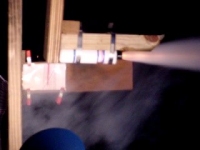
Click Here for a video of this static test
(1.1 meg download, 4 seconds of video)
Or Click Here for an Excel
spreadsheet analyzing this test |
* There is really very little waste, as the container
was rinsed with water until the stuck-on propellant dissolved. The
same rinse water was used several times for this purpose, and became very
rich. It was boiled, poured into flat pans, and placed in the oven
to make a very nice batch of recrystallized propellant. |
10/12/03B Replication of 10/11/03B but with larger
grain
Same as above, but 120.2 gram grain used. Burned well, but ISP
registers 89. Should be higher. Maybe I will try the fuel-rich
version again!
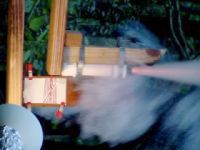
Click Here for a video of this static test
(1 meg download, 4 seconds of video)
Or Click Here for an excel
spreadsheet analyzing this test |
Flash! It occurs to me
that I am not controlling the moisture content of this propellant very
well. This batch is particularly wet (10/12/03A). It solidifies
OK, holds its shape, and is even a bit brittle. But it weeps thick
syrupy goo upon long heating in the oven, so I know there is extra moisture.
If a large fraction of this propellant is water, that could account
for the reduced ISP. So I will have to find a way to regulate the
moisture content. Perhaps I will consult a cookbook! Where
is Betty Crocker when you need her... |
|
|
So it looks
like sugar syrup propellant has potential. It is much easier to make
than recrystallized propellant, and the process seems to be about as safe.
Three motors made with this propellant performed fairly well, and the other
two might have done OK with some adjustments. It also looks like
the recrystallization approach produces a better propellant, thus might
be worth the extra trouble when higher performance is desired.
Next... Improvements made over the Winter Holiday. Click
Here for that page.
Jimmy Yawn
jyawn@sfcc.net
10/6/03
rev. 10/13/03








